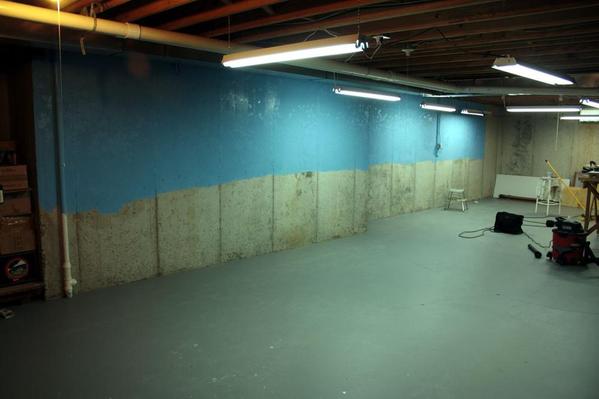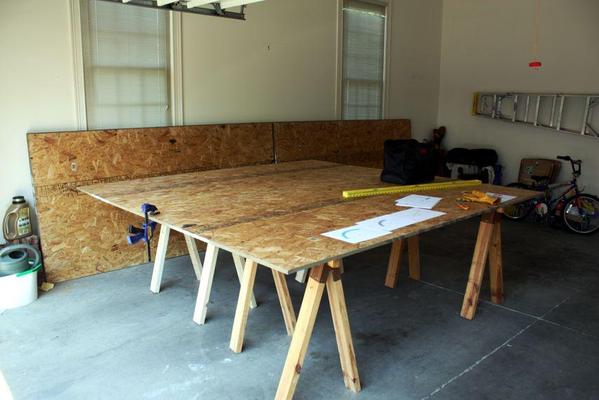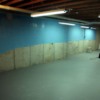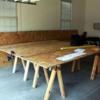The walls are painted, but the patches do show since they're higher than the surrounding concrete. I don't think it will be too noticeable from the distance people will be looking at it (+10 feet), and the clouds and other backdrop painting will further confuse the viewer.
In this picture, the paint wasn't yet dry (flat) and it was wetter on the patches since they didn't absorb the water-based paint at the same rate as the old concrete. Notice how I saved lots of paint (and labor) by only going as far down as the railroad is going up.
I was originally going to use Tapcons to hold the angled brackets to the back wall, but was advised by some colleagues that they're not to be trusted in pull-out loads. They're okay in sheer, but I may come down the basement one day and find the back of the layout on the floor. I took them back to Home Depot and bought 1/2" wedge bolts. Those will not break loose.
Well... today I bit the bullet and got into the garage to start cutting out the OSB roadbed pieces. I built another set of sawhorses just to hold a second 4 X 8 next to the one I'm laying out. Many of the curves have centers that fall off the primary sheet. I clamped two pieces together so I could locate the off-sheet center point with my Rotape compass rule.
Doubling up the sheet's a bit of a pain since I can't reach all the way to the center, but if all goes according to plan, I will only have to double up the sheets this one time since the pieces I cut have the radii that I'm using for all the rest of the curved pieces and will serve as templates. I just have to locate the starting and ending points of the curve, hold the correct radius piece up to those points and then trace the curve without having to use the Rotape. In fact, I'm going to hammer in some brads at these end points so I just push the curve up to the brads and trace away. It should speed things up since it took longer to lay out the piece than to cut it.
I laid out and cut all the pieces of sheet A. That was five pieces including two large sweeping curves. My computer locations came out very close to the real world and that was a relief. I used the circular saw to do the straight cuts and my 30 year-old Sear Craftsman saber saw for all the curves. That saw is USA made with an all aluminum housing, variable speed trigger and build like a truck. It just keeps going and going. My circular saw is new and is a Skil with the laser alignment thingy (that's a technical term).
I was glad to see how clean cut sheet edges are. I was worried about using OSB instead of plywood, but so far so good. My original layout used plywood (sperrholz) that I bought in Germany. Their standard lumber is a higher quality than standard US lumber. The ply was 7 layer instead of 5, and was completely knot free.
Funny story here: When I built the first layout in Germany, I laid all of the pieces out based on what I thought a metric-sized plywood sheet would be. I just assumed that they would have something equivalent to a 4 X 8, which I figured was a 1 X 2 meter sheet. I get to the builder's supply store and show the associate the plan, and he claims, "Falsch, falsch!" meaning, "wrong, wrong!", and I ask "Warum?" (why?) so he takes me over to a piece of ply, pulls out his tape and measures it. Guess what? It's a 4 X 8, it just measured in metric. So it comes out to 1.22 X 2.44 meters. So it was "back to the drawing board", literally! It killed another whole week since I was working full-time, and they closed early like all other German businesses with very truncated Saturday hours and no Sunday sales. I had to re-draw all the cutting templates since the sheet size was so different than my assumption. But none of their other dimensional lumber was an English measure shown in metric; they were all true metric sizes. But not the plywood.
It's a bit of a challenge to throw a 4 X 8, 19/32 piece of OSB onto those horses all by myself, but I persisted. It's not that it's so heavy (64 pounds), but it's so unwieldy. My first attempts would have been great on "America's Funniest Home Videos". The saw horse fell over towards me a nd
almost smashed my toe, but almost doesn't count.
I'm keeping all the scrap of a usable size and proportion. There's going to be all sorts of opportunities to use all sorts of pieces of OSB during the construction.
It will get easier going forward since it's always the planning and worrying that seems to take all the mental energy. Once you get into action it becomes easier with each piece. I've spent almost 3 years thinking about this rebuild, and at some point it almost seems like an impossibility.
Also, sheet A was one of the more complicated with 5 pieces. And none of the pieces will have trouble getting down the cellar steps.








